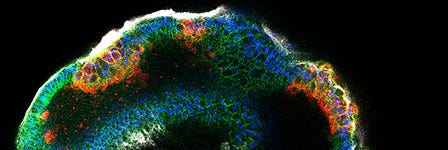Organoid Research
One of the most exciting advancements in stem cell research of the past decade has been the development of organoid systems. Explore below for a basic overview of organoids and resources to support your organoid culture.
What Are Organoids?
Organoids are three-dimensional (3D) cell cultures that incorporate some of the key features of the represented organ. These in vitro culture systems are characterized by the self-organization of multiple, organ-specific cell types into a spatial organization similar to what is observed in vivo, and are capable of recapitulating some functions of the represented organ.1-4
How Are Organoids Made?
Organoids may be generated from adult stem cell-containing tissue samples, single adult stem cells, or via the directed differentiation of pluripotent stem cells.3,4 Due to the active stem cell population that are present in some organoid model systems, the organoids can be greatly expanded. For example, up to 1 x 106 liver organoids can be produced from a single progenitor within 5 to 6 weeks, giving researchers a highly robust and scalable platform for studying a wide range of subjects.4,5
Organoid Culture
To date, organoid culture systems have been developed to model tissue structures from all three primary cell lineages.3,4,6 Although tissue-specific culture methods vary, in general, appropriate pluripotent stem cells or tissue-specific progenitor cells are embedded in Matrigel® or another appropriate extracellular matrix. The cells are grown in the presence of cell culture media containing specific growth factors that mimic the in vivo signals required to maintain the stem cell population. Under these conditions, the embedded cells proliferate and self-organize into 3D organoid structures that, with many systems, can be passaged and maintained indefinitely.1,7 Additionally, these cultures have shown remarkable genetic stability during passaging; whole genome sequencing of liver organoids clonally expanded from a single liver progenitor cell revealed only one synonymous base substitution after three months in culture.8 To date, organoid cultures have been described for a variety of tissues, including intestinal,5,9,10 liver,11,12 pancreas,13 kidney,14 prostate,15,16 lung,17,18 optic cup,19 and brain.20
Tools and Technologies for Organoid Culture
Organoids are revolutionizing in vitro cell culture by providing accessible, physiologically relevant models that faithfully recapitulate key elements of the modeled tissue. Use these optimized media to efficiently generate organoids for your research.
Organoid Media Kits
Spend less time troubleshooting and more on experimenting with optimized organoid media kits for the growth and maintenance of organoids from primary tissue and human pluripotent stem cells.
Future Directions and References
Organoid technology holds great potential as a tool to study a wide range of subjects, including developmental biology, disease pathology, cell biology, regenerative mechanisms, precision medicine, and drug toxicity and efficacy testing. For these and other applications, organoid cultures provide highly informative, complementary approaches to the well-established 2D-culture methods and animal model systems.4,7,21,22 This technology also holds tremendous potential for regenerative medicine, as organoids present the possibility for autologous and allogeneic cell therapy through the replacement of damaged or diseased tissue with organoid-propagated tissue or stem cell populations.23,24 Such an application would allow correction of genetic abnormalities in vitro using CRISPR-Cas9 and re-introduction of the engineered healthy cells into the patient, with subsequent integration into the tissue.25,26 Patient-derived organoid cultures have also proven valuable as diagnostic tools in precision medicine applications. Organoids derived from patient samples have been used to screen patient drug responses in vitro before administering treatment to direct the care and predict therapeutic outcomes of cancer and cystic fibrosis patients.10,27,28 As the list of organoid culture systems and the techniques for their experimental exploitation grows, the utility and broad applicability of organoids continues to gain recognition across a wide range of research disciplines. The development of these culture systems represents an exciting advancement in the tools available to researchers working in basic research, and in translational and clinical contexts.
References
- Sato T & Clevers H. (2013) Science 340(6137): 1190–4.
- Wells JM & Spence JR. (2014) Development 141(4): 752–60.
- Lancaster MA & Knoblich JA. (2014) Science 345(6194): 1247125.
- Huch M & Koo B-K. (2015) Development 142(18): 3113–25.
- Spence JR et al. (2011) Nature 470(7332): 105–9.
- Kretzschmar K & Clevers H. (2016) Dev Cell 38(6): 590–600.
- Clevers H. (2016) Cell 165(7): 1586–97.
- Huch M et al. (2015) Cell 160(1–2): 299–312.
- Sato T et al. (2009) Nature 459(7244): 262–5.
- Sato T et al. (2011) Gastroenterology 141(5): 1762–72.
- Huch M et al. (2013) Nature 494(7436): 247–50.
- Takebe T et al. (2013) Nature 499(7459): 481–4.
- Huch M et al. (2013) EMBO J 32(20): 2708–21.
- Takasato M et al. (2014) Nat Cell Biol 16(1): 118–26.
- Karthaus WR et al. (2014) Cell 159(1): 163–75.
- Gao D et al. (2014) Cell 159(1): 176–87.
- Lee J-H et al. (2014) Cell 156(3): 440–55.
- Dye BR et al. (2015) Elife 4 4: e05098.
- Eiraku M et al. (2011) Nature 472(7341): 51–6.
- Lancaster MA et al. (2013) Nature 501(7467): 373–9.
- McCracken KW et al. (2014) Nature 516(7531): 400–4.
- Bigorgne AE et al. (2014) J Clin Invest 124(1): 328–37.
- Yui S et al. (2012) Nat Med 18(4): 618–23.
- Fordham RP et al. (2013) Cell Stem Cell 13(6): 734–44.
- Dekkers JF et al. (2013) Nat Med 19(7): 939–45.
- Schwank G et al. (2013) Cell Stem Cell 13(6): 653–8.
- van de Wetering M et al. (2015) Cell 161(4): 933–45.
- Dekkers JF et al. (2016) Sci Transl Med 8(344): 344ra84.
Scientific Resources for Organoid Research
Select the organoids you’re interested in to access technical and scientific resources to support your research, including webinars, videos, protocols, technical tips, and more.






